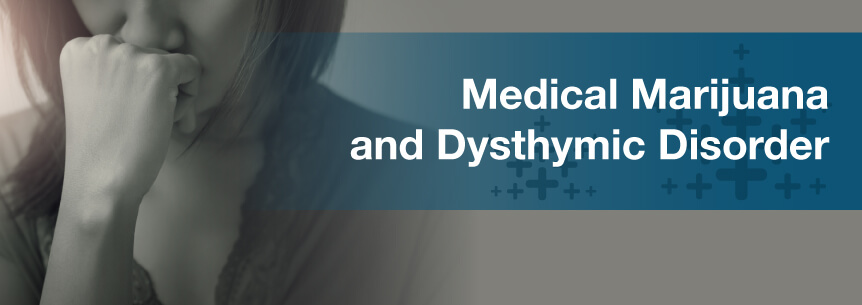
Dysthymic disorder goes by several names, including dysthymia and persistent depressive disorder. The condition can develop during childhood, but physicians can miss diagnosing it then. While relapse is a reality, treatment, which can include medications, psychotherapy and medical marijuana for dysthymic disorder, can help sufferers enjoy a better quality of life.
The etymology of the term helps you understand its scope and definition. The term dysthymia has Greek origins of “dys,” meaning “bad” or “ill,” and “thymia” means “emotions” or “mind.” Taken together, dysthymia is a mild and chronic form of depression characterized by a low mood.
It’s not severe enough to meet the guidelines for major depressive disorder (MDD), but dysthymia tends to last longer than MDD. Technically, major depressive disorder and persistent depressive disorder are two separate conditions, but overlaps occur.
A doctor will diagnose you with dysthymic disorder if you have a low or depressed mood that persists at least two years — or one year, for children and adolescents — lasts most of the day and occurs on most days.
People with dysthymia can have transient periods where they are in a normal mood. However, typically, people with the disorder have a domination of lower spirits, versus normal or good moods. Mental health professionals diagnose the condition, as no laboratory tests yet exist for its diagnosis.
Dysthymic disorders occur with at least two of the following symptoms:
Unlike major or clinical depression, dysthymic disorder doesn’t have a significant impact on mental, motor and psychic abilities, but it can significantly affect physical and psychological well-being and limit some functions. Individuals with persistent depressive disorder can often go about their day, but may not feel quite right emotionally and mentally.
Dysthymia is a mild and chronic form of depression that may cause you to lose interest in activities you once enjoyed and feel a general low mood, hopelessness and inadequate self-esteem. While the symptoms can vary by person, common symptoms of persistent depressive disorder include:
Dysthymia is not as severe as major depression, but your depressed moods may be anywhere from mild to severe. People in your life may describe you as gloomy, moody, irritable, continually complaining or incapable of having a good time. The symptoms may come and go for years, and the intensity can change over time.
People who have dysthymic disorder are at risk of relapse and experiencing other life problems, such as marital, financial and career-related issues and setbacks. They are also at risk for developing double depression, which occurs when you already have a dysthymic disorder and experience a major depressive episode concurrently.
Doctors have not determined the exact reason for any form of dysthymic disorder, but there may be several causation factors related to it. Biological changes and brain chemistry are likely to play a role in the development of a dysthymic disorder. There is also a genetic component to depression. Traumatic life events, such as the death of a loved one, can also trigger dysthymia, as can having anxiety. Also, people who have a substance abuse issue can develop the disorder.
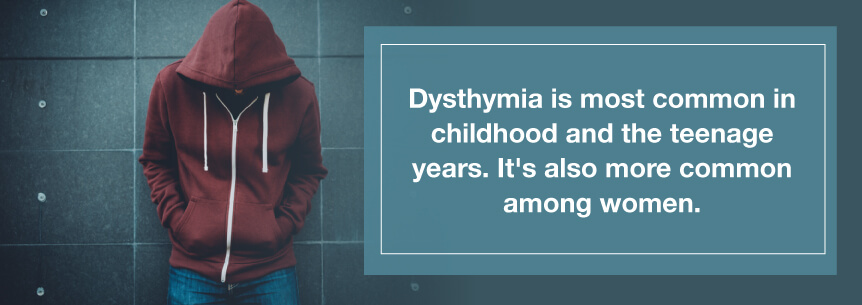
Dysthymia is most common in childhood and the teenage years. It’s also more common among women. This mild form of depression also tends to occur with other types of mental illness, such as anxiety disorders and substance abuse.
Dysthymic disorder is a mild case of depression that comes in many forms. Without treatment, dysthymia can worsen into other types of depression such as major depressive disorder.
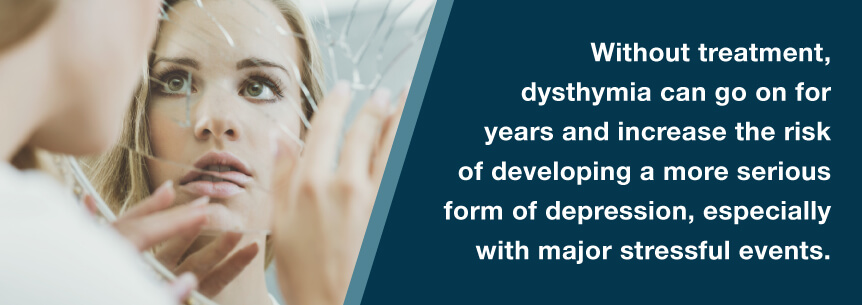
Other forms of depression related to dysthymic disorder include the following.
When diagnosing dysthymic disorders, physicians strive to rule out bipolar disorders because they treat the two conditions differently.
Most people do not receive a dysthymia diagnosis until long after it develops, because most people consider low mood to be a personality trait and don’t think to tell their doctor. Dysthymic disorder can also occur with other mental disorders and get masked by the more intense symptoms of other diseases.
Without treatment, dysthymia can go on for years and increase the risk of developing a more serious form of depression, especially with major stressful events. On its own, dysthymic disorder can also affect many areas of your life and lead to difficulty sleeping, trouble concentrating, appetite problems, apathy and a lack of motivation. These symptoms can make it difficult to maintain your job, relationships and overall health.
The research community has collected quite a few statistics surrounding dysthymic disorder. These include:
It usually takes a combination of psychotherapy and medication to treat dysthymic disorder. Sometimes physicians and therapists recommend lifestyle changes.
While there is no way to prevent dysthymic disorder, the medical community suggests watching for it in children who are a risk of developing it then, during their adolescent years or even their early adult years.
Unfortunately, a common theme exists with this disorder whereby a substantial number of sufferers do not enjoy a sustained recovery. Physicians and psychotherapists recommend maintenance treatment to reduce the risk of relapse.
As you know, dysthymic disorder is a type of mood condition characterized by irritable mood or mild depression lasting over two years. It has fewer symptoms and is less severe than major depression.
Some evidence does show cannabis helps with some psychiatric conditions — mainly bipolar disorder and depression. Some individuals even call it “green Prozac.” Harvard School of Medicine’s emeritus professor of psychiatry, Lester Grinspoon, believes marijuana has huge potential in treating mental illness. But, like all medication, it might not work for everyone.
Certain studies conducted on young adult and recreational users showed variable results. Some showed a negative link between cannabis use and depression or anxiety, while others showed a positive link. Some showed no link at all. Because of the result’s diverse pattern, researchers believe there are other factors coming into play with cannabis use to affect depression and anxiety. Also, much of the research is contradictory and none is really conclusive.
Also, researchers observed the simple relations between cannabis use and symptoms of depression differed from those of more complicated models. Essentially, when cannabis use was the only thing under consideration, there was a positive link. However, the models that included other factors, like multiple temperament and personality factors, along with baseline depression or anxiety, showed a more negative link.
Medical marijuana and dysthymic disorder treatment can help treat a variety of related symptoms, including:
Once doctors evaluate depression symptoms, like with dysthymic disorder, they often prescribe medications, many of which are antidepressants. However, many people find the side effects of many antidepressants to be unpleasant, or even harmful. In some cases, they are worse than the depression symptoms. Some of these unwanted side effects of antidepressants include:
Medical cannabis for dysthymic disorder can work well in treating these types of side effects.
The trend among medical weed and health conditions seems to be weed helps with certain symptoms of the health condition, but when it comes to mood disorders, marijuana tends to take a step further by healing and generating a lasting impact. Certain cannabis and dysthymic disorder strains seem to positively affect depression specifically, as well as bipolar’s depressive side.
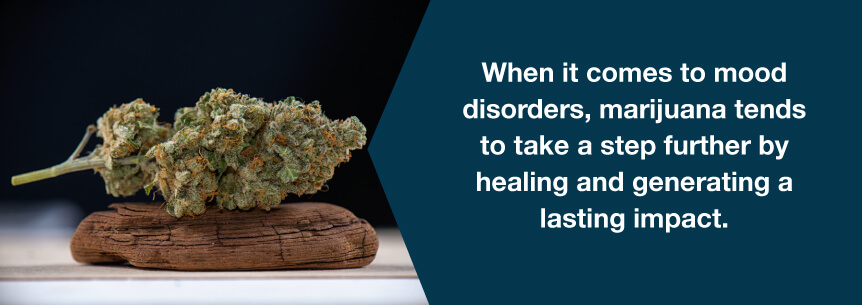
Even though marijuana can offer help reduce the negative impact of mood disorder symptoms, like lack of appetite, insomnia, aggression, fatigue, etc., it also can help relieve the depression itself in some individuals.
Some potentially helpful marijuana and dysthymic disorder strains to try include:
You may need to work with your marijuana doctor or experienced budtender to find the best strain for you.
A good rule of thumb when first getting started with medical marijuana for dysthymic disorder treatment is to start off slowly with a low dose, and don’t take any more of the treatment until you’ve fully realized the effects of your first dose. You won’t always feel medical marijuana kicking in immediately. Therefore, going slow and starting low allows you to experiment until you find the perfect dose for what you’re experiencing.
Here are some forms of cannabis administration you can try.
Inhalation: With inhalation methods, the effects are almost immediate. Forms include:
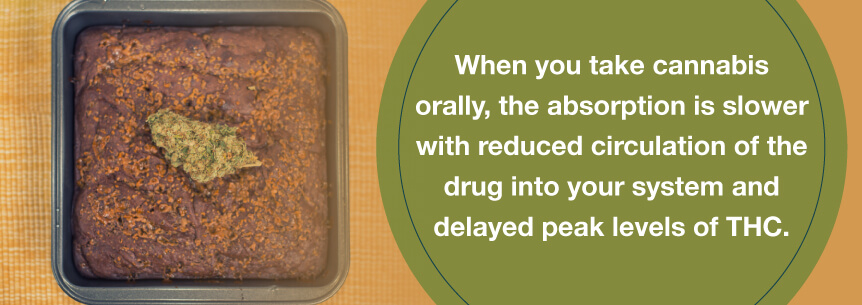
Oral administration: When you take cannabis orally, the absorption is slower with reduced circulation of the drug into your system and delayed peak levels of THC. Forms of taking marijuana orally include:
There are also topical delivery methods, too, like creams, lotions, balms and salves. Some forms of marijuana ingestion work faster than others.
If you’re interested in starting cannabis for dysthymic disorder treatment and are searching for a cannabis doctor or clinic, your one-stop resource is Marijuana Doctors. The doctors listed at Marijuana Doctors are fully screened to ensure they all comply with strict state laws. Therefore, you can feel safe that you’re working closely with a trustworthy and credible cannabis doctor.
Marijuana Doctors is proud to be one of the top resources for coordinating medical weed recommendations, and we’ve assisted innumerable patients in finally finding the relief they need from their medical conditions. Find a cannabis doctor you can trust and book your appointment today so you can start your marijuana for dysthymic disorder treatment and be the next patient we assist in finding relief.
And, if you’re new to cannabis, read our Tips for First-Time Medical Marijuana Patients blog post to learn more about the herb, the conditions it can help treat and how to get a recommendation and medical marijuana card.
Find A Doctor Find A Dispensary